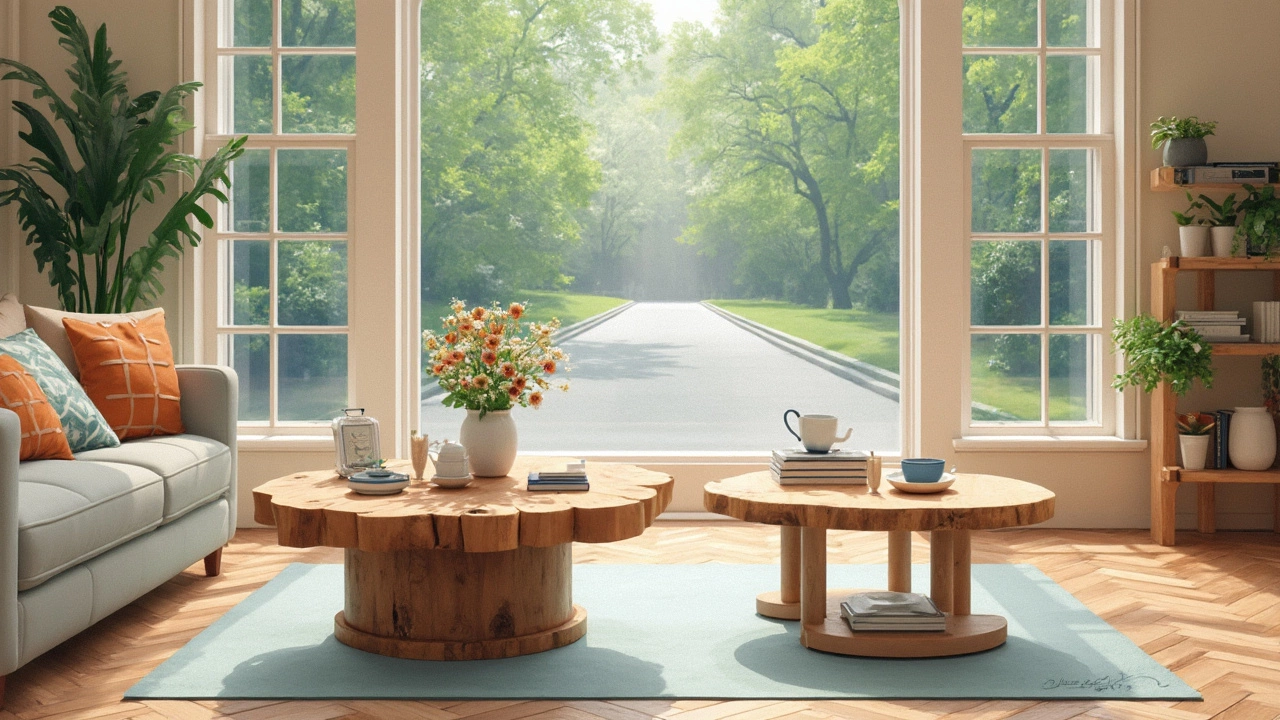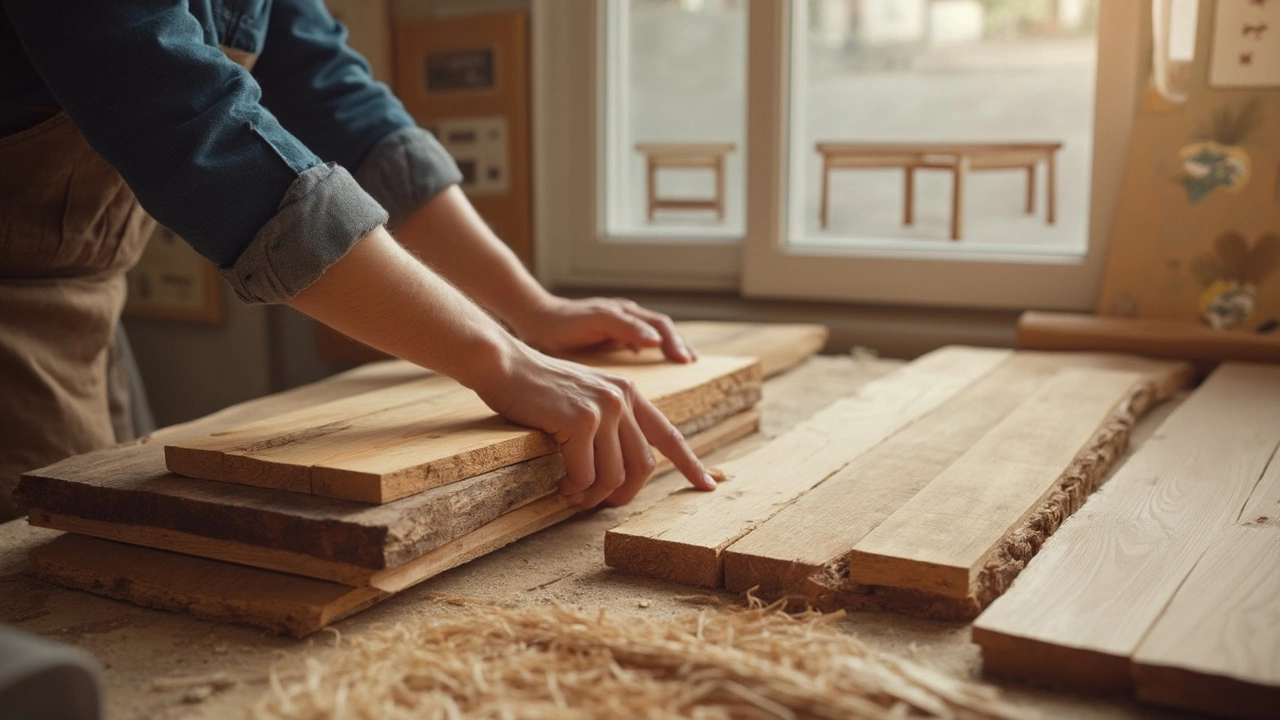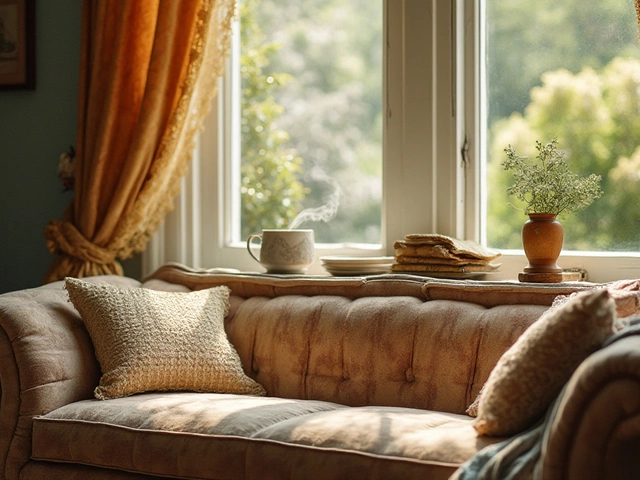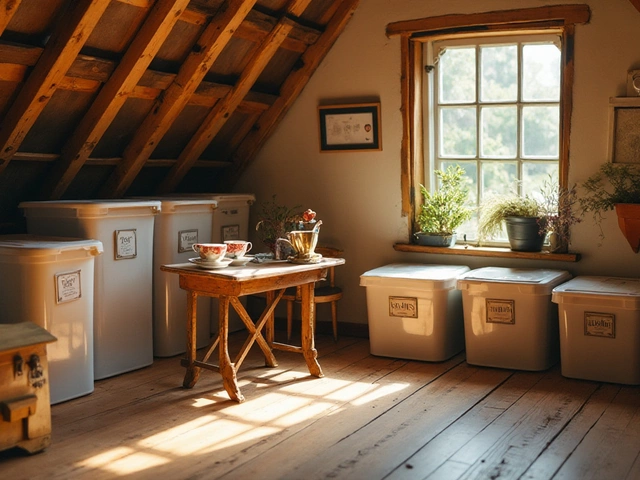Ever picked up a coffee table that feels flimsy as cardboard? Or seen one that looks so bulky it might outlast the couch? The thickness of the wood in a coffee table matters more than most people think. It decides if your table can handle dropped books, full coffee mugs, or kids doing their homework (and probably a few crafts disasters).
Here’s the real deal: If the wood is too thin, you risk cracking, sagging, or dents. Too thick, and the whole thing becomes heavy and awkward to move—not to mention the price goes up fast. Most well-made coffee tables use a top somewhere between 3/4" to 1 1/4" thick, but there are reasons why you might want to go outside that range. Getting it right the first time means your table isn’t just pretty, but built to last real life.
- Why Wood Thickness Matters
- Standard Thicknesses Explained
- When to Go Thicker (and Why)
- Risks of Thin Wood Tops
- Table Frame and Design Considerations
- Helpful Wood Selection Tips
Why Wood Thickness Matters
If you want your coffee table to hold up over time, wood thickness isn’t just a minor detail. It’s actually one of the biggest factors in how sturdy the table feels and how much weight it can support. The thickest part—usually the tabletop—does the heavy lifting, holding whatever you plop down without bowing in the middle.
Go too thin, and you may notice the table flexing when you sit something heavy, like a stack of books or a big tray. Thicker wood is less likely to bend, crack, or dent. Even wood experts agree: thicker materials distribute weight better and absorb daily knocks more easily. This gets especially important for coffee tables, which often double as footrests, kids’ snack zones, and sometimes makeshift work desks.
The actual look and style of your table also tie directly into wood thickness. Chunkier tops make a table stand out and give that solid, stable vibe. Thinner tops work for more minimal, modern spaces, but you can’t skimp on support or you’ll end up disappointed. That’s why most trusted furniture makers use wood that’s at least 3/4 inch thick for the table’s surface.
One last thing: wood type changes the rules a bit. Softer woods like pine need to be thicker than something like oak because they dent easier. A solid, appropriately thick coffee table top is your best bet for a long-lasting, everyday piece you won’t be babying or repairing all the time.
Standard Thicknesses Explained
If you walk into a furniture store or scroll through coffee table listings online, you’ll notice a sweet spot for wood thickness. Most store-bought coffee tables feature tops measuring between 3/4 inch (about 19mm) and 1 1/4 inch (about 32mm). This range has become the norm for a reason: it balances strength, looks, and everyday use.
Here’s a quick breakdown of common thicknesses and what they’re best for:
- 3/4 inch (19mm): The most popular thickness, especially for mass-produced tables. It’s sturdy enough for normal use, keeps the table light, and it’s cheaper because it uses less wood.
- 1 inch (25mm): Offers extra beefiness without being too heavy. This is often what higher-end brands use for a more substantial look.
- 1 1/4 inch (32mm): Gives off that chunky vibe and feels solid, but the table will be noticeably heavier. Perfect for rustic or farmhouse styles.
Here’s how these numbers line up side-by-side:
| Thickness | Uses | Pros | Cons |
|---|---|---|---|
| 3/4" (19mm) | Modern, lightweight, DIY projects | Affordable, easy to move | Can feel light or flex under a lot of weight |
| 1" (25mm) | Most living room tables | Sturdy, classic look, still manageable weight | Slightly more expensive and heavier |
| 1 1/4" (32mm) | Farmhouse, industrial, heavy-use tables | Super strong, feels premium | Heavy, pricier, harder to move |
If you want your coffee table to look and feel right at home with the rest of your furniture, stick to this range. Anything thinner, and you’re in risky territory unless you add a support frame underneath. Anything thicker, and your table starts acting more like a weightlifting bench.
When to Go Thicker (and Why)
So when is it smart to use thicker wood for a coffee table? It all comes down to what you want the table to do—and how you want it to look. Going for a chunkier, more solid feel or planning for serious daily use? You’ll want to bump up that thickness. Let’s get into the details.
If you’re building a big coffee table (think over 40 inches long) or one that needs to support heavy stuff—like stacks of books, board games, or even those who use the table as a footrest every single night—a thicker top (1" to 1 1/2") is just safer. It helps avoid sagging in the middle. Plus, thicker wood can survive more bumps and knocks from everyday life. I’ve seen tables made from 2" reclaimed barn wood go decades with barely a dent.
There’s a style factor too. Thicker tops fit right in with chunky farmhouse, industrial, and modern-rustic designs. If you want your table to be the room’s centerpiece, a beefier profile just looks right compared to skinny particle board.
- You want extra durability for families, parties, or busy living rooms.
- You plan to use heavy materials, like hardwoods (oak, maple, walnut).
- You love the bold look of coffee tables in high-end furniture stores.
- You’re building without a ton of extra support underneath the tabletop.
On a numbers level, check out how different thicknesses hold up:
| Wood Thickness | Max Tabletop Width Before Sagging (in.) | Ideal Uses |
|---|---|---|
| 3/4" | 36-40 | Light use, small tables |
| 1" | 44-48 | Standard living areas |
| 1 1/4"+ | Up to 60 | Large, heavy-use tables |
Basically, go thicker if you want something that lasts, feels solid, and will handle rough days without complaining. Thicker wood means fewer worries about your table flexing or breaking down the line. If you’re planning a family game night or just want peace of mind, don’t skimp on the thickness.

Risks of Thin Wood Tops
Going too thin with your coffee table top is usually asking for trouble. Most of the time, if you use wood that's less than 3/4" thick, you might start seeing problems surprisingly fast. You’ll get dents or maybe even cracks if someone drops something heavier than a TV remote on it. Thin tops are much more likely to end up with a noticeable sag, especially on tables over three feet long. Put your feet up (come on, everyone does it) and that new table might never be level again.
There’s also a comfort factor: when the table feels too light, it wobbles easily if you nudge it. Many folks return lightweight tables or complain online about the cheap feel—they just don’t hold up to everyday use. Makers know this, which is why you rarely find solid wood tops from reputable furniture brands under 3/4". And if you want to use softwoods like pine or spruce, the risk doubles since those get dented and scratched even more easily.
If you think of going even thinner (like half an inch), maybe to save money or make a modern look, you’ll probably end up seeing glue seams open or even small splits appear after a few months. Coffee tables have to stand up to groceries, books, laptops, and yes—sometimes a sneaky house cat. If you want yours to last, don’t go too thin.
Here's how thin coffee table tops typically compare to thicker ones in a home setting:
| Wood Thickness | Weight Capacity (lbs) | Likelihood of Sagging | Resistance to Dents |
|---|---|---|---|
| 1/2" | ~30 | High | Low |
| 3/4" | ~50 | Moderate | Medium |
| 1" | ~80 | Low | Good |
| 1 1/4"+ | 100+ | Very Low | Excellent |
So, if you want your coffee table to take a beating and keep its shape, play it safe with a top that’s at least 3/4" thick. Skip anything thinner unless you’re after a temporary piece or just a decorative prop—not everyday use.
Table Frame and Design Considerations
The frame isn’t just what holds a coffee table together—it’s what lets you get creative while keeping the whole thing stable. The thickness of your tabletop wood does a lot, but the legs, apron, and support stretchers are the heavy lifters. If you try to use thin wood for the top, you absolutely need a strong frame underneath to prevent sagging—most pros recommend a 1-1/2” to 2” thick apron for good support.
With chunkier tops (think over 1-1/4” thick), you can sometimes get away with a more minimal frame, but don’t skip it unless you love fixing wobbly coffee tables. If you’re ever at IKEA, check out those super-thin tables—they usually hide a support layer or use engineered wood to cheat the look.
The frame design impacts loads on the tabletop, especially if folks rest their feet or you pack on hardcover books. Here’s a quick rundown of recommended frame features for common table styles:
- Traditional coffee tables: Full apron around all four sides, legs at least 1-1/2” square, and wood joinery for long-term strength.
- Modern minimalist tables: Metal frames can work since steel is strong, but with wood, double-check the stretchers under the top.
- Farmhouse/rustic tables: Usually beefier all over. Aprons and legs from 2" stock wood hold thick tops, but even these need proper joinery.
Don’t overlook fasteners, either. Pocket screws, wood glue, and corner brackets make a coffee table last way longer—no creaks or wobbles down the line. Being practical, if you use plywood for the top, add a 1” edge band all around to hide the layers and boost strength at the same time.
For the stats fans, here’s a quick table with load guidelines so your coffee table doesn’t surprise you in a bad way:
| Feature | Recommended Value |
|---|---|
| Top Thickness | 3/4" to 1 1/4" |
| Apron Thickness | 1 1/2" to 2" |
| Leg Size | 1 1/2" square or more |
| Max Load (evenly spread) | 100-200 lbs |
If you’re planning a bigger or unusually shaped table, just remember: support is cheaper than replacing a busted top. A solid frame with smart wood choices is what keeps a coffee table going for decades—no matter what life throws at it.
Helpful Wood Selection Tips
Picking the right wood for your coffee table is about way more than just what looks good at the shop. The wood species you choose affects strength, price, style, and how much work you'll put in to keep it nice over time. If you want your coffee table to handle daily life without constant repairs, here are the things to focus on.
First, look at wood hardness. Hardwoods like oak, maple, and cherry are popular because they resist dents and scratches better than softer woods. Softwoods, like pine or fir, might be easier to shape (and cheaper), but they’ll show marks sooner. Here’s a quick comparison table with some numbers:
| Wood Type | Janka Hardness (lbf) | General Cost | Durability |
|---|---|---|---|
| Pine | 380 | Low | Fair |
| Red Oak | 1290 | Medium | High |
| Maple | 1450 | Medium-High | Very High |
| Walnut | 1010 | High | High |
| Cherry | 950 | High | High |
Second, check for warping and knots. Straight, tight grain means the board is less likely to bend or crack down the line. Avoid wood with a bunch of open knots or warps—those are weak points that could turn into headaches.
Moisture content matters, too. Wood should be dry, ideally around 6-8% moisture for indoor furniture. Lumber yards often test this with a meter, or you can buy a cheap moisture reader online. Wet wood will shrink or twist once you bring it home, wrecking your hard work.
Here’s a quick shortcut for sizing lumber at the store: standard plywood is often 3/4" thick, but for a solid slab top, go for boards that measure at least that thick or beefier if you want a chunkier style. Remember, veneer or engineered woods are usually lighter and budget-friendly but don't hold up to deep scratches or heavy use like real hardwood.
If you’re buying from a store, don’t be afraid to lay the board flat and press down in the middle. Wiggle it a bit, see if it flexes more than you'd expect. Solid pieces with less flex will last longer (and make you trust the table under your cup of coffee).
“Stick with stable, kiln-dried hardwoods if you want something that won’t warp the minute the seasons change,” says Nick Offerman, master woodworker and star of Parks and Rec. “Moisture is the enemy of a flat tabletop.”
And finally, always factor in the finish. A good finish does more than make your table pretty—it seals the wood, blocks spills, and adds years of life. Polyurethane is tough and easy to clean, but if you want a more natural vibe, consider an oil or wax finish (though those may need more upkeep).
- Pick hardwood for strength and dent resistance.
- Look for straight, dry boards with tight grain.
- Test for flex and watch out for big knots or deep cracks.
- Get a good finish on top—polyurethane if you want it bulletproof.
With the right wood choice, you’ll spend less time worrying about scratches and more time actually enjoying your coffee table.



